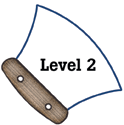
Alaska Science
Key Element D6
A student who meets the content standard should act upon reasoned decisions and evaluate the effectiveness of the action.
 |
Alaska Science A student who meets the content standard should act upon reasoned decisions and evaluate the effectiveness of the action. |
|
Performance Standard Level 2, Ages 8–10
|
|
|
|
Sample Assessment Ideas
|
Standards Cross-References
|
||
|
National Science Education Standards Design a solution or product. Students should make and compare different proposals in the light of the criteria they have selected. They must consider constraints, such as cost, time, trade-offs, and materials needed, and communicate ideas with drawings and simple models. (Page 165) Implement a proposed solution. Students should organize materials and other resources, plan their work, make good use of group collaboration where appropriate, choose suitable tools and techniques, and work with appropriate measurement methods to ensure adequate accuracy. (Page 165) Evaluate completed technological designs or products. Students should use criteria relevant to the original purpose or need, consider a variety of factors that might affect acceptability and suitability for intended users or beneficiaries, and develop measures of quality with respect to such criteria and factors; they should also suggest improvements and, for their own products, try proposed modifications. (Page 165) Communicate the process of technological design. Students should review and describe any completed piece of work and identify the stages of problem identification, solution design, implementation, and evaluation. (Page 166) Science cannot answer all questions and technology cannot solve all human problems or meet all human needs. Students should understand the difference between scientific and other questions. They should appreciate what science and technology can reasonably contribute to society and what they cannot do. For example, new technologies often will decrease some risks and increase others. (Page 169) |
Benchmarks Because of their ability to invent tools and processes, people have enormous effect on the lives of other living things. (Page 55) |
|
Table of Contents | Return to Alaska Native Knowledge Network